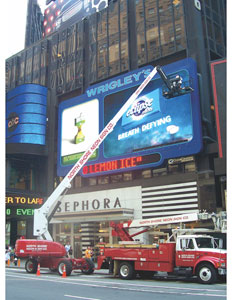Many jobs require reaching overhead areas. Sometimes it’s no more than six feet off the ground. Other times it can be one hundred feet or more.
But no matter the height, accessing those overhead areas efficiently and safely is essential.
In years past, overhead access was accomplished by climbing ladders or erecting scaffolding. Today more and more people are getting to overhead work faster and more safely by using aerial work platforms. These machines quickly elevate workers directly to an overhead area, so no time is wasted erecting scaffolding and no energy is wasted climbing up to the job.
Aerial work platforms can be purchased or rented and are available in a variety of styles and sizes to fit almost any overhead access need. The leading manufacturer offers over sixty different models including vertical personnel lifts, slab and rough terrain scissor lifts, and telescoping and articulating boom lifts featuring platform heights of up to 150 feet.
With such a wide variety of machines available, there’s a model that will match your needs whether you’re using it indoors or outdoors, on a solid concrete surface, or driving through mud.
But selecting the right machine requires more than just knowing how high you want to reach. If you don’t look at all your needs, you may end up with a machine that doesn’t work like you planned.
Here are some things to consider when selecting a machine:
Reach
Obviously platform height (how high will it reach) is the number one criteria. But what good is a machine that is capable of reaching the desired height if, because of job site conditions, you can’t position the machine directly under the work area?
In this case, look at both height and horizontal outreach capabilities. You need to determine where you can position the machine first, then you can determine what machine will give you the combination of height and horizontal outreach you need to access the work area.
Power
Is the work area located inside or outside? Various power sources are available—including gas, diesel, or dual fuel engines and AC or DC power—to meet these different applications.
Where noise is a concern in outdoor areas, electric-powered boom lifts up to sixty feet in height are available.
Surface
Look at the terrain around the job site. Is it a concrete slab or soft earth? Is it level or sloped?
If it’s sloped, you may need a machine with more gradeability. And if there’s a lot of debris scattered around, you may need a machine with higher ground clearance. Boom lifts with additional outreach or rough terrain scissorlifts with outriggers may be required.
Next look at the surface you’re going to travel over.
Watch for any hollow spaces beneath the ground. If it’s soft or muddy, you may need four-wheel drive or a machine with a crawler undercarriage.
You can also choose from a variety of tire options—including foam-filled, pneumatic, high-floatation “turf tires” or solid non-marking tires for use on wood flooring or tile and marble surfaces.

Weight
Is the surface firm enough to support the machine weight?
Determine if there are any weight restrictions in places where you will be using the machine. Many areas like parking structures, bridges, and sidewalks have load limits.
Location
No matter what machine you select, you have to be able to move it from its point of delivery on the job and around the job site to the actual work area.
See if there are any low clearance areas or overhead obstructions where the stowed height of the machine might be critical or if there are any “tight” areas you need to pass through where a narrow overall machine width or tighter turning radius might be required. If so, you may have to use an articulated boom lift or a boom lift with an articulated jib to reach up and over obstacles.
Capacity
What is the work requirement? How many people are required for the application and how much material is needed? This will dictate the platform size and capacity required.
Check the platform capacity of the machine to determine how many people and tools or supplies it will hold. You’ll also want to look at the platform size to make sure it will provide you with an adequate working area and that it will accommodate your largest load.
Once you have decided on what type and size of machine best meets your needs, consider the type of work you’ll be performing from the elevated platform and what tools you’ll be using to do the work. Along with electrical outlets and air lines on the platform, today’s leading manufacturers offer a variety of optional features that will increase your productivity even more when you reach the overhead area.
Built-in generators in the base, with power cable and air/water lines running through the boom to the platform, are available to power everything from welders and plasma cutters to saws, pressure washing systems, and lighting packages.
Using these integrated tool systems in the platform increases productivity, eliminates the need for costly ancillary equipment, and provides a much safer working environment, since you don’t have wires or hoses running over the side of the platform to the ground.
Conclusion
Aerial work platforms have changed the way we work. They make us more productive and provide a greater degree of safety than other methods of accessing overhead areas.
With the wide variety of products on the market today, there’s a machine for almost any application.
So take the time to review all of your needs and job site parameters before selecting a machine and ask questions before you order. It could save you a whole lot of time and trouble on the job.
By William Hindman, president of Industrial Marketing Systems in Fountain Hills, Arizona.
Photos: JLG.











